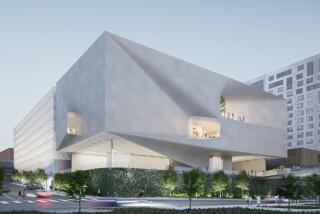Architect John Kelsey dies at 86; designer of Pasadena museum
While designing what is now the Norton Simon Museum in Pasadena in the late 1960s, architects John Kelsey and Thornton Ladd expressed a belief: Space that houses art “can be part of the event and experience.”
When it opened in 1969 as the Pasadena Art Museum, observers saw art in the striking curvilinear exterior, which was clad in mottled tiles that appeared to change color with the sun, and in the curved interior walls conceived to showcase modern art.
An early review by The Times pronounced the structure “eye-catching” and “undoubtedly superior to its only local competition, the Los Angeles County Museum of Art.”
After forming the firm Ladd & Kelsey in 1958, the two USC graduates built a number of major projects over the next quarter-century, including main buildings at CalArts in Valencia and Busch Gardens, a theme park in Van Nuys.
Kelsey, 86, died Aug. 4 of complications related to old age at his Santa Barbara home, his family said.
In “An Architectural Guidebook to Los Angeles” (2003), architectural historian Robert Winter wrote that the museum drew upon the Streamline Moderne style of the 1930s while reflecting “a formal classic quality.”
After the museum opened to great fanfare, it quickly sank into debt and was taken over by industrialist Norton Simon in 1974. Architect Frank Gehry led a major reconfiguration of the gallery space in the late 1990s to better display Simon’s vast collection of masterpieces, according to the museum.
For CalArts, Ladd & Kelsey designed what the partners called a “mega-building,” a unified complex with 150 spaces that encompassed eight theaters, galleries and other technical facilities. The Times called the plans for the behemoth “virtually unprecedented,” and Kelsey touted the flexibility of the design.
“There isn’t a traditional classroom in the building,” Kelsey had said of the planned classrooms, which could easily be reconfigured “to fit the needs of the instructor.”
Their inspiration for CalArts — originally developed by Walt Disney — had come from ancient Athens, Rome and Renaissance Europe, according to the architects.
They also drew plans for another Disney project, Mineral King Ski Resort, which was proposed for the Sierra Nevada but blocked after the land became part of Sequoia National Park in 1978.
Anheuser-Busch opened Busch Gardens in 1966 on 17 acres adjacent to the brewery. The $4-million project was both theme park and tropical oasis and included a monorail that snaked around the facility to allow passengers a peek at the brewing process. The park was closed in 1979 so the brewery could expand.
A lower-profile project, the modern First Methodist Church in La Verne, was showcased in the 1967 movie “The Graduate,” when Dustin Hoffman’s character pounds on the glass to interrupt the wedding near the end of the film.
Other Ladd & Kelsey designs include Occidental College’s Herrick Memorial Chapel; USC’s Student Activities Complex; twin eight-story residence towers at what is now Claremont McKenna College; and a number of May Co. department stores.
In Pasadena, the partners designed a three-bedroom home for the Kelsey family that was built in 1962 and wraps around a pool. The family sold the home just north of Annandale Country Club in 1978. It sold in 2003 for $1.85 million.
“The architect’s own house is a beautifully articulated ... structure,” Winter wrote in his guidebook. “This low-lying, modern structure is as handsome as when it was built.”
John Field Kelsey was born Dec. 7, 1925, in Los Angeles, the youngest of three boys. After his father died just before the Depression, Kelsey lived in San Francisco and Los Angeles with his mother.
Near the end of World War II, he was an Army Air Forces cadet before attending USC’s school of architecture.
His partnership with Ladd endured until 1982, when Kelsey moved to Santa Barbara and concentrated on designing contemporary homes. Ladd died in 2010 on his 86th birthday.
Kelsey was “always interested in form,” taking up sculpture in the 1970s and painting in an abstract style, said his son, Brent, who is also an architect.
“He was very funny and had a great personality, and wasn’t shy about expressing his opinion,” his son said. “But he was usually right.”
The twice-divorced Kelsey is survived by Catherine, his wife of 30 years; three children from his first marriage, Brent, Elizabeth and Jennifer; two grandchildren; and a brother, Richard.
More to Read
Start your day right
Sign up for Essential California for the L.A. Times biggest news, features and recommendations in your inbox six days a week.
You may occasionally receive promotional content from the Los Angeles Times.







